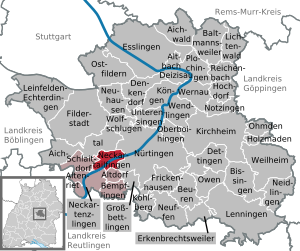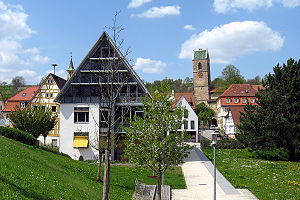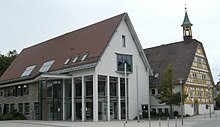Neckartailfingen
| coat of arms | Germany map | |
|---|---|---|

|
Coordinates: 48 ° 37 ' N , 9 ° 16' E |
|
| Basic data | ||
| State : | Baden-Württemberg | |
| Administrative region : | Stuttgart | |
| County : | Esslingen | |
| Height : | 282 m above sea level NHN | |
| Area : | 8.26 km 2 | |
| Residents: | 3846 (December 31, 2018) | |
| Population density : | 466 inhabitants per km 2 | |
| Postal code : | 72666 | |
| Area code : | 07127 | |
| License plate : | ES, NT | |
| Community key : | 08 1 16 041 | |
| LOCODE : | DE NTA | |
| Address of the municipal administration: |
Nürtinger Strasse 4 72666 Neckartailfingen |
|
| Website : | ||
| Mayor : | Gerhard Gertitschke | |
| Location of the municipality of Neckartailfingen in the Esslingen district | ||
Neckartailfingen is a municipality in the Esslingen district in Baden-Württemberg . It belongs to the Stuttgart region (until 1992 the Middle Neckar region ) and the European metropolitan region of Stuttgart .
geography
Geographical location
Neckartailfingen is located on the Neckar , about 25 kilometers south of Stuttgart . The old town center is on the left of the Neckar. After the Second World War , most of the building was to the right of the Neckar, creating the so-called “suburb”.
Neighboring communities
Neighboring communities are Aichtal in the north, Nürtingen in the east, Altdorf in the south, Neckartenzlingen in the south-west and Schlaitdorf in the west (all Esslingen district).
Community structure
Apart from the village Neckartailfingen, no other places belong to Neckartailfingen. The lost Liebenau Castle is located in the municipality .
Division of space

According to data from the State Statistical Office , as of 2014.
history
Until the 19th century
Neckartailfingen was first mentioned in a document as Tagelvingen in 1090 in the Hirsauer Codex ( Codex Hirsaugiensis ). The place then belonged to the Counts of Urach and the Counts of Achalm, who were related to them . According to the entries, the Counts Liutold (also known as Liutolf) and Cuno von Achalm donated several goods and their share in the church to the Hirsau monastery . The exact date of the donation is not recorded in the Hirsau Codex, but after Count Cuno von Achalm died in 1092, the donation was dated to around 1090 . On behalf of the Hirsau Monastery, the Romanesque St. Martin's Church was probably completed in 1111 (according to the dendrochronological examination of the roof beams). Between 1254 and 1265 the Counts of Württemberg bought the county of Urach including Achalm Castle . Neckartailfingen also belonged to this estate, which then became part of Württemberg , to which it belonged until the new state of Baden-Württemberg was founded in 1952. The place became Protestant in 1536 together with the Nürtingen office and in 1541 received the first village school in the old Nürtingen district. During the Thirty Years War , Neckartailfingen was sacked by Colonel Walter Butler's infamous dragoons (mainly from Croatia) after the Battle of Nördlingen in 1634 and burned down completely except for the church, the wine press, a house and two small huts. The village had effectively ceased to exist. It was only after a few years that the people who had fled returned and slowly rebuilt their village.
With the purchase by the Württemberger they transferred the administration of the village to the Vogtei Nürtingen. The Oberamt Nürtingen emerged from the Vogtei in 1758 .
Since 1598 the Stuttgart - Urach postal line has maintained a post office in the village. In 1807, the first post office in the old district of Nürtingen was set up at the Neckartailfingen traffic junction, not in the Oberamtstadt Nürtingen.
District affiliation
From 1938 to 1973 Neckartailfingen belonged to the district of Nürtingen , with which it rose in the district of Esslingen.
Population development
- 1824: 854 inhabitants
- 1834: 971 inhabitants
- 1861: 1,039 inhabitants
- 1900: 963 inhabitants
- 1939: 966 inhabitants
- 1946: 1,410 inhabitants
- 1950: 1,484 inhabitants
- 1961: 1,842 inhabitants
- 1970: 2,772 inhabitants
- 1987: 3,274 inhabitants
- 1991: 3,364 inhabitants
- 1995: 3,684 inhabitants
- 2005: 3,889 inhabitants
- 2010: 3,771 inhabitants
- 2015: 3,716 inhabitants
politics
mayor
The mayor (formerly called the mayor ) was elected by the local council from among its members until 1891, and it was not until 1891 that the local citizens elected the mayor directly.
- 1820–1837: Wilhelm Perrenon
- 1837–1848: Conrad Friedrich Fischer
- 1848–1881: Heinrich Wendel Wenzelburger
- 1883–1898: Carl August Holl
- 1899–1922: Georg Friedrich Wenzelburger
- 1922–1945: Emil Pfeiffer
- 1945–1949: Paul Maurer
- 1949–1955: Emil Pfeiffer
- 1955–1971: Emil Bauer
- 1971–1998: Wilhelm Preißing
- 1998-2014: Jens Timm
- since 2014: Gerhard Gertitschke
Municipal council
The local council in Neckartailfingen has 14 members. The local elections on May 26, 2019 led to the following final result. The municipal council consists of the elected voluntary councilors and the mayor as chairman. The mayor is entitled to vote in the municipal council.
| Parties and constituencies |
% 2019 |
Seats 2019 |
% 2014 |
Seats 2014 |
||
| FFW | Free Progressive Electoral Association | 56.48 | 8th | 60.80 | 8th | |
| JB / CDU | Young Citizens' Association / CDU | 30.16 | 4th | 27.80 | 4th | |
| SPD-FB | SPD / Free Citizens | 13.36 | 2 | 11.30 | 2 | |
| total | 100.0 | 14th | 100.0 | 14th | ||
| voter turnout | 67.17% | 58.6% | ||||
coat of arms
Official blazon from 1951: "A golden (yellow) wall hook in red (inverted Z with pointed ends and slightly inclined shaft)." This coat of arms goes back to a landmark Neckartailfingen from 1683.
Economy and Infrastructure
traffic
Neckartailfingen has always been a transit point for many vehicles. At the time of the stagecoach, Neckartailfingen was an important station for changing horses.
Until 1976, the Deutsche Bundesbahn maintained a station on the Plochingen – Tübingen line, known as the Neckar-Alb-Bahn , which was around two kilometers from the town. This was finally closed due to unprofitability and the station building was demolished. Today the platforms are overgrown and overgrown.
In 1995 the bypass road of the B 297 was completed and the flood protection for the place was completed. This road runs in a tunnel between the town center and the Neckar. In the west, the B 312 in the direction of Stuttgart or Reutlingen passes Neckartailfingen.
Local public transport is served by the VVS bus routes 188 (to Nürtingen ) and 190 (to Aich ). Line 75 (to Bernhausen or Degerloch ) only stops on the outskirts.
education
Neckartailfingen has a primary school with the Liebenau School . There are also three kindergartens in town. A music school currently provides around 713 students from the town and the surrounding area with an extensive range of courses.
Supply and disposal
The power grid in the community is operated by EnBW Regional AG. There is a natural gas supply. The community is a member of the Filderwasserversorgung association , whose waterworks are located in Neckartailfingen. A sewage treatment plant is operated to purify the wastewater. The waste management company of the Esslingen district is responsible for waste disposal.
Culture and sights
Natural monuments
9 natural monuments enrich the place. Including the Lutherlinde planted in 1883, the northern part of the Aileswasensee, the Neckaraltarm with floodplain forest west of the bridge of the B 312 and various field hedges, wet meadows and field trees.
Aileswasensee
The Aileswasensee was created by a gravel works, today the lake with a restaurant and several "beaches" is a popular national excursion destination. At the deepest point it is 4 meters deep. A nudist beach is available. Fishing is reserved for the fishing club.
Martinskirche
The Martinskirche is known nationwide because of its Romanesque style and age. Its leaning tower is best known. It was probably completed in 1111. As a result of the Reformation it became Protestant in 1536 and is now part of the Nürtingen church district .
Neckar Bridge
In 1847 the wooden bridge over the Neckar, endangered by floods and drift ice, was replaced by a massive 6-arched sandstone bridge. When the Neckar bridges between Nürtingen and Tübingen were blown up as planned by the German Wehrmacht in April 1945 to stop the advance of the French troops, the Neckartailfinger bridge was the only one that was spared - according to contemporary witnesses, through courageous intervention from the site and fortunate circumstances.
Personalities
Sons and daughters of the church
- Johann Adam Kurrer (1714–1761), pastor, professor in Bebenhausen
- Karl Albert Wilhelm Bacmeister (1845–1920), senior church councilor, military pastor and dean
- Lore Wissmann (1922–2007), opera singer
People who lived and worked in Neckartailfingen
- Agnes Sapper (1852–1929), writer and wife of the official notary at the time.
- Hermann Drück (1856–1931), painter, almost exclusively landscape painter. Born as the son of the city school in Vaihingen an der Enz , died in Neckartailfingen.
- Hans Reyhing (1882–1961), teacher in Neckartailfingen and Swabian local poet
- Zdenko von Kraft (1886–1979), Austrian writer, lived in Neckartailfingen.
- Grace Hoffman (1921–2008), American opera singer, spent her retirement in Neckartailfingen
- Matthias Jaissle (* 1988), soccer player, grew up in Neckartailfingen.
Individual evidence
- ↑ State Statistical Office Baden-Württemberg - Population by nationality and gender on December 31, 2018 (CSV file) ( help on this ).
- ↑ State Statistical Office, area since 1988 according to actual use for Neckartailfingen.
- ^ Adolf Kuppler: 200 years of post in Neckartailfingen. Verlag Gerd Rieker, Neckartailfingen 2007, p. 17.
- ↑ BDEW (Ed.): Map of the electricity network operator 2012. Frankfurt 2012.
- ^ Neckartailfingen parish with picture, accessed on June 26, 2010
- ^ Hans Schwenkel: Heimatbuch des Kreis Nürtingen, Volume II. 1953, pp. 626–627.
literature
- Hans Schwenkel : Home book of the Nürtingen district. Volume 2. Würzburg 1953, pp. 610-635.
- Christoph Drüppel and Anita Raith: History of the Neckartailfingen community. Neckartailfingen 2000, ISBN 3-00-006512-1 .
- The district of Esslingen published by the Baden-Württemberg state archive. V. with the district of Esslingen, Jan Thorbecke Verlag, Ostfildern 2009, ISBN 978-3-7995-0842-1 , Volume 2, p. 181.
Web links
- Website of the municipality , accessed on October 7, 2010









